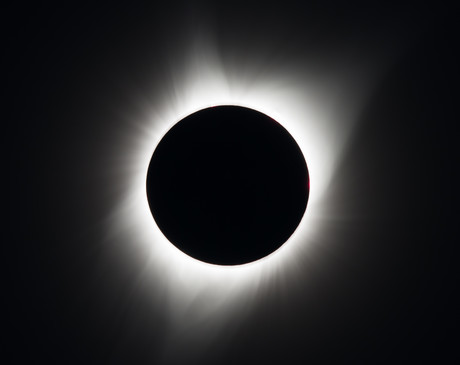Ionospheric changes during solar eclipses

Earth’s ionosphere was the subject of scrutiny by an army of amateur radio operators.
When a solar eclipse plunged the US into darkness on 21 August, Nathaniel Frissell was stationed directly along the shadow’s path, leading one of the largest experiments in the history of space science from the back porch of a cabin in Gilbertsville, Kentucky.
With a 31 m long-wire antenna, he made contact with a network of ham radio operators he’d assembled around the world to test the strength and reach of their HF signals as one measure of the eclipse’s impact on Earth’s atmosphere. Around 200 operators — from New Jersey to India — had signed on to be ‘citizen scientists’ that day by recording their contacts with one another.
“Among other phenomena, we’re hoping to use our radio transmissions to identify how much of the ionosphere is impacted by the eclipse and how long the effects last,” said Frissell prior to the event. Frissell is an assistant research professor of physics at the New Jersey Institute of Technology’s (NJIT) Center for Solar Terrestrial Research, and a sophisticated practitioner of ham radio who is intent on elevating the technology’s role in space science research. He will share data and analysis from the day at the American Geophysical Union annual meeting in December.
Frissell had spent more than two years preparing for the event. While a PhD student at Virginia Tech, he founded the Ham Radio Science Citizen Investigation (HamSCI), an organisation that connects professional researchers such as space physicists and astronomers with the amateur radio community. By merging their data, the different groups hope to construct a comprehensive picture of atmospheric effects caused by space weather events ranging from the solar eclipse to more common phenomena, such as solar flares. In 2014, he first demonstrated the use of ham radio data by showing the effects of an X-class solar flare on HF.
According to a paper co-authored by Frissell (‘HamSCI and the 2017 Total Solar Eclipse’), “The continental United States is well-instrumented to study eclipse-induced ionospheric effects, as it contains a suite of instrumentation including GPS Total Electron Content (GPSTEC) receivers, ionosondes, Super Dual Auroral Radar Network (SuperDARN) radars, and other ionospheric instruments capable of obtaining data at an unprecedented level of detail. Even so, the ionosphere is vast and remains under sampled, and therefore additional data sources are welcome complements to existing measurement systems.”
Members of Frissell’s NJIT team of undergraduate ham radio operators, including Spencer Gunning, Joshua Vega and Joshua Katz, developed a website and data analysis tools that enabled them to gather and interpret the observations generated during the eclipse.
“We’ll be participating in an international data-collection effort, learning more about the space weather effects of the eclipse, exposing the general public to amateur radio and watching a beautiful once-in-a-lifetime solar event all on the same day,” Katz said prior to the event. “That’s more excitement than programmers and data analysts like me are usually allowed to have in a single sitting!”

A major source of HamSCI data comes from the Reverse Beacon Network (RBN). The Reverse Beacon Network is an automated radio (1.8–144 MHz) receiving network created and maintained voluntarily by ham radio operators.
“What’s exciting from a researcher’s perspective is that people have access to tools such as digital radios and computers that are connected in ways they weren’t in the past, allowing us to make observations and then collect and share them,” said Frissell.
“For us, this is an unusual opportunity to learn things we don’t know about the ionosphere,” he added. “This is one of the very few times we’re able to conduct a controlled experiment around a space weather event. Normally, we have no advanced knowledge over when, where and how they happen.”
Frissell noted that the eclipse was expected to change the ionospheric state and possibly create communication paths that do not normally exist. His team was on the lookout for those and other changes.
“If you suddenly alter the ionosphere as happens during an eclipse, by reducing the number of ions or changing the temperature, for example, does it create waves or instabilities?” he said. “How far can these effects be detected?”
Indeed, early results suggest the shadow of the eclipse stopped ion production in the ionosphere, as well as the suggestion of a decrease in both maximum usable frequency and D-layer absorption. Amateur operators observed Doppler shifts, phase shifts and amplitude changes in WWV, WWVB and AM radio station reception, and observations suggest a raising of the F layer and depletion of the D layer.
Also arranged for the eclipse was a ‘QSO party’, which was a great success, with 571 submitted logs and 28,694 QSOs from 5201 unique call signs (including 864 from outside the US).
Adapted from information issued by NJIT.
The new wildfire reality: mapping a response
Firefighter-turned-researcher Chris Dunn is helping pioneer data-driven solutions to tackle...
ARCIA update: LMR is not dead yet
Be it mining, rail, public safety, transport or utilities, everyone is embracing new technology...
Towards 1 Tbps throughput using sub-terahertz bands
In order to enable the near-instantaneous communication promised by 6G, ultrahigh data speeds...






